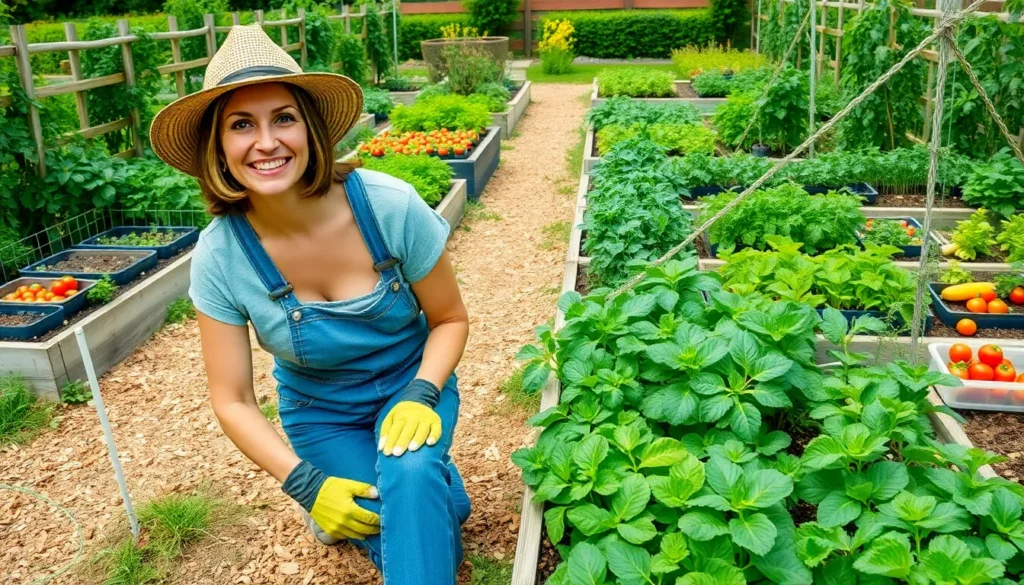Creating a thriving vegetable garden starts with smart planning and strategic layout design. We’ve all dreamed of harvesting fresh tomatoes, crisp lettuce, and vibrant peppers right from our backyard, but knowing where to place each plant can make the difference between a bountiful harvest and a disappointing season.
Whether you’re working with a sprawling backyard or a compact urban space, the right vegetable garden layout maximizes your growing potential while minimizing maintenance headaches. We’ll show you how companion planting, proper spacing, and thoughtful organization can transform your garden into a productive powerhouse.
From traditional row gardens to innovative square-foot layouts, there’s a perfect design waiting for every gardener. Let’s explore proven strategies that’ll help you create a vegetable garden that’s not just productive, but also beautiful and easy to maintain throughout the growing season.
Square Foot Gardening Layout for Maximum Efficiency
Square foot gardening transforms small spaces into highly productive growing areas. We’ve found this method particularly effective for maximizing vegetable yields while minimizing maintenance.
Dividing Your Garden Into Manageable Sections
Creating distinct sections allows us to organize crops based on their exact needs and growth patterns. We typically establish 4×4 foot raised beds that divide into sixteen individual square foot sections, making plant management straightforward and accessible.
Separating high maintenance vegetables like tomatoes and peppers into their own squares prevents overcrowding and simplifies care routines. We place these larger plants in corners or edges where they won’t shade smaller crops throughout the growing season.
Grouping compatible plants within adjacent squares creates beneficial growing partnerships. We position herbs like basil next to tomato squares and place lettuce near taller plants that provide afternoon shade during hot summer months.
Installing physical dividers such as thin wooden strips or string helps maintain clear boundaries between sections. We use these markers to track which varieties we’ve planted in each square and monitor their individual progress.
Plant Spacing Guidelines for Square Foot Gardens
Large vegetables require one full square foot per plant for optimal growth and production. We allocate individual squares for crops like tomatoes, peppers, eggplants, broccoli, and cabbage to ensure adequate root space and air circulation.
Medium sized plants fit comfortably with four plants per square foot in most garden conditions. We typically plant bush beans, lettuce heads, Swiss chard, and spinach using this spacing to maximize yield without compromising plant health.
Small vegetables thrive when planted nine per square foot for efficient space utilization. We arrange herbs like basil, cilantro, and parsley in grid patterns within each square to create dense productive plantings.
Tiny crops accommodate sixteen plants per square foot for maximum space efficiency. We use this dense spacing for radishes, green onions, and carrots, ensuring proper thinning as plants mature.
| Plant Size | Plants Per Square | Examples |
|---|---|---|
| Large | 1 | Tomatoes, Peppers, Broccoli |
| Medium | 4 | Bush Beans, Lettuce, Spinach |
| Small | 9 | Basil, Cilantro, Parsley |
| Tiny | 16 | Radishes, Green Onions, Carrots |
Best Vegetables for Compact Square Foot Layouts
Leafy greens excel in square foot gardens due to their shallow root systems and quick maturation. We recommend lettuce, spinach, arugula, and kale as reliable options that produce multiple harvests throughout the growing season.
Compact root vegetables maximize underground space while requiring minimal surface area. We plant radishes, carrots, beets, and turnips in dense configurations that yield substantial harvests from small garden squares.
Bush varieties of traditionally sprawling plants work exceptionally well in confined spaces. We choose bush beans, compact tomatoes, dwarf peppers, and determinate varieties that maintain manageable sizes without sacrificing productivity.
Fast growing herbs provide continuous harvests while occupying minimal garden space. We include basil, cilantro, parsley, and chives in our square foot layouts for fresh seasoning and natural pest deterrent benefits.
Short season crops allow multiple plantings throughout the year for sustained harvests. We succession plant lettuce, radishes, and spinach every two weeks to maintain constant fresh vegetable availability in our compact garden spaces.
Row Gardening Layout for Traditional Appeal
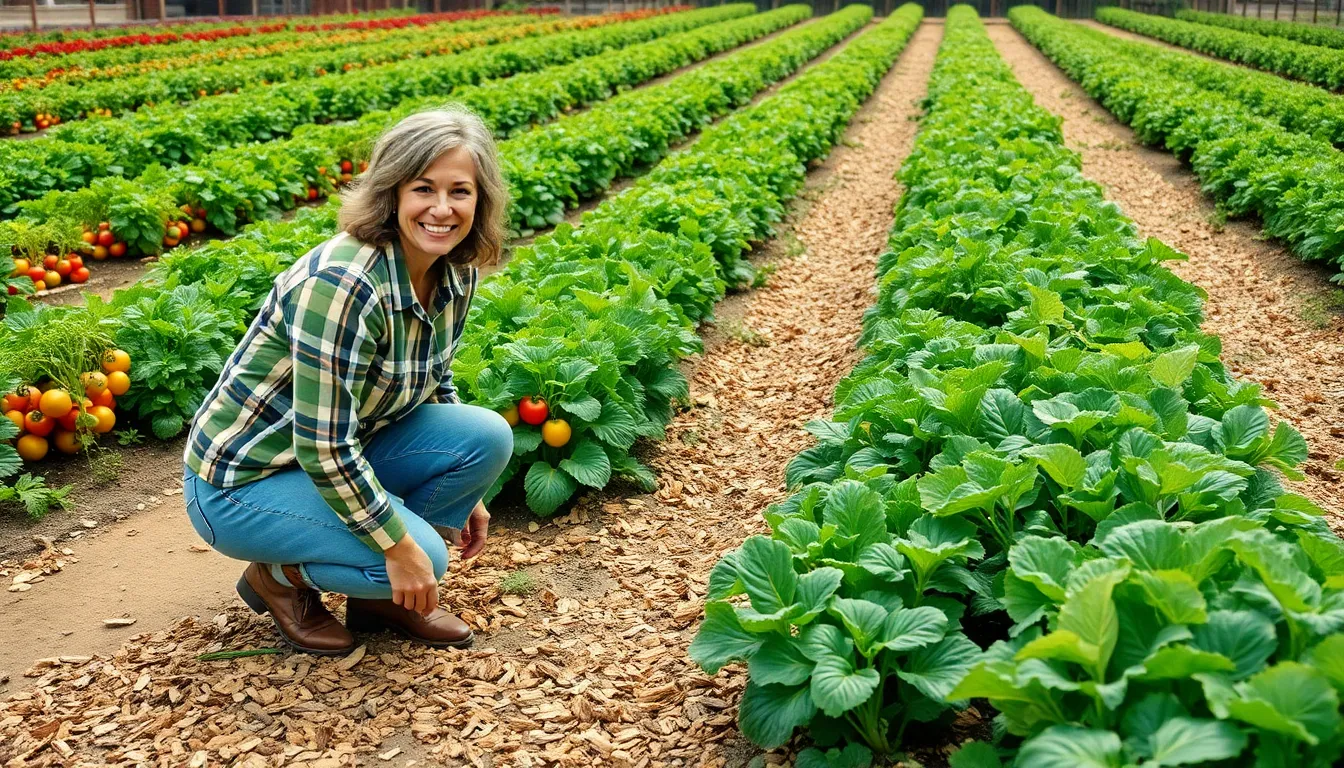
Row gardening offers a time-tested approach that maximizes space efficiency while maintaining the classic appeal of traditional vegetable gardens. We’ll explore proven strategies for organizing plants in straight lines that deliver consistent harvests.
Creating Straight Rows with Proper Spacing
Straight rows running north to south capture optimal sunlight exposure throughout the day. We recommend placing the tallest plants at the north end of your garden layout, followed by medium-height varieties, and finishing with the shortest plants at the south end to prevent shading issues.
Wide rows measuring around 30 inches provide excellent space efficiency while retaining soil moisture more effectively than narrow alternatives. These dimensions also make irrigation simpler and more uniform across your garden vegetable layout. But, we should note that soil in wide rows tends to stay cooler for longer periods, which can delay early spring plantings.
Plant spacing within each row depends on the mature size of your vegetables. Large crops like tomatoes and peppers need 18-24 inches between plants, while smaller vegetables like lettuce and radishes can be spaced 4-6 inches apart.
Companion Planting Within Row Systems
Companion planting transforms traditional rows into productive partnerships between different vegetables. We pair plants that naturally benefit each other’s growth patterns and pest resistance.
Marigolds planted alongside tomato rows create a natural pest deterrent system that protects your harvest without chemical interventions. Similarly, beans paired with corn in alternating sections provide nitrogen fixation that benefits both crops while maximizing vertical growing space.
Basil planted at the ends of tomato rows enhances flavor development while deterring common garden pests through its natural aromatic compounds. These strategic partnerships increase overall garden productivity within your traditional row layout.
Managing Pathways Between Vegetable Rows
Pathways measuring 2-3 feet wide ensure comfortable access for maintenance, harvesting, and equipment movement between rows. We’ve found this width accommodates wheelbarrows and allows two people to work simultaneously without crowding.
Materials like wood chips, straw, or gravel keep pathways clean and prevent weed growth that competes with your vegetables. These pathway materials also improve garden aesthetics while providing functional benefits like moisture retention and soil temperature regulation.
Strategic pathway placement connects all garden sections while minimizing wasted growing space. We position main pathways to provide access to water sources and storage areas, with smaller connecting paths between individual rows for detailed maintenance work.
Raised Bed Vegetable Layout Designs
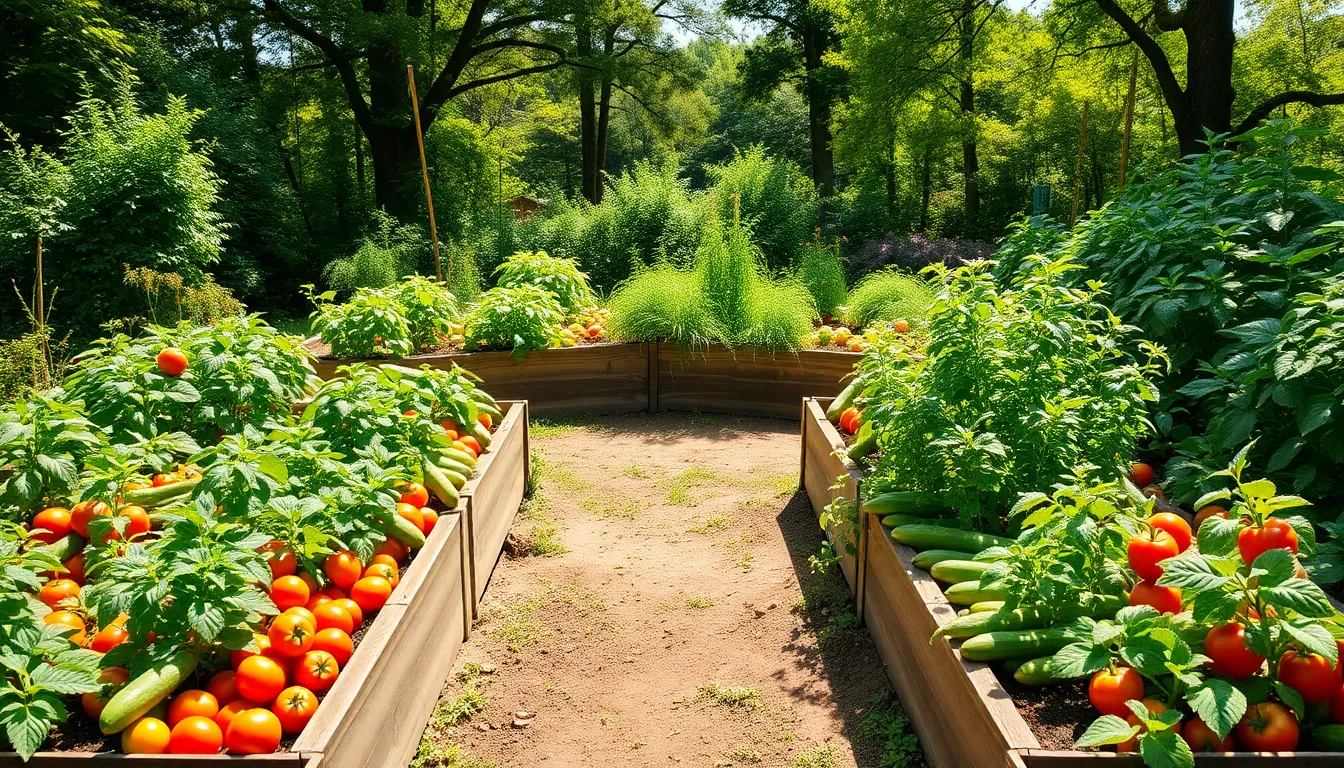
Raised bed gardening transforms how we approach vegetable cultivation by offering superior drainage, soil control, and organized growing spaces. These elevated garden structures allow us to create customized layouts that maximize both productivity and visual appeal.
Rectangular Raised Bed Configurations
Rectangular raised beds offer the most versatile foundation for our vegetable gardens, with 4×8 foot dimensions providing optimal space for diverse plantings. We can organize multiple rows of vegetables like tomatoes, peppers, cucumbers, kale, and root vegetables within these practical structures. Narrow beds up to four feet wide ensure we can easily reach the center from either side, making maintenance and harvesting effortless for gardeners of all experience levels.
Succession planting becomes highly effective in rectangular configurations, where spaces left by mature plants immediately accommodate new crops throughout the growing season. Companion planting thrives in these layouts as we pair vegetables alongside beneficial herbs like basil to enhance growth and naturally deter pests. Dividing beds into dedicated sections enables proper crop rotation, ensuring soil health while preventing nutrient depletion from repeated plantings of the same vegetable families.
Adding compost between plantings replenishes essential soil nutrients, maintaining the fertility that rectangular raised beds require for continuous production. These configurations accommodate both intensive planting methods and traditional spacing, giving us flexibility to adapt our approach based on exact crop requirements.
Circular and Curved Raised Bed Options
Circular raised beds create stunning focal points while challenging us to maximize every square inch of growing space through creative planning. These curved designs offer exceptional aesthetic appeal that transforms functional vegetable gardens into industry features worthy of admiration. Planning becomes more complex with circular layouts as we must carefully consider plant placement to ensure efficient space utilization and maintain easy access to all areas.
Curved raised beds work particularly well for herb gardens and compact vegetables that don’t require extensive linear spacing. We can create beautiful spiral patterns or concentric circles that guide the eye while organizing plants by height and growth habits. These designs often incorporate pathways that curve naturally through the garden space, creating a more organic flow compared to rigid rectangular arrangements.
Accessibility requires special attention in circular configurations, as we need to ensure no planted areas become unreachable without stepping on growing beds. Strategic placement of stepping stones or narrow access points helps maintain the curved aesthetic while preserving practical functionality.
Multi-Level Raised Bed Arrangements
Tiered gardens maximize vertical growing space in small areas by stacking multiple levels of raised beds at varying heights. We can design each level to accommodate different plant types based on their exact sunlight requirements and soil depth needs. Lower levels work perfectly for root vegetables that need deeper soil, while upper tiers suit shallow rooted herbs and leafy greens.
Multi level arrangements create natural accessibility options for gardeners with mobility considerations, bringing plants to comfortable working heights. Each tier receives different amounts of sunlight exposure, allowing us to match sun loving vegetables with the brightest levels while placing shade tolerant crops in naturally shadowed areas.
Drainage considerations become critical in tiered systems as water flows from upper levels to lower ones, requiring careful planning to prevent oversaturation. We can incorporate retaining walls, terraced slopes, or stepped configurations that manage water flow while creating visually striking garden architecture.
These arrangements often incorporate built in seating areas or storage spaces between levels, transforming purely functional raised beds into multi purpose garden features that serve both cultivation and recreation needs.
Vertical Gardening Layout to Maximize Space
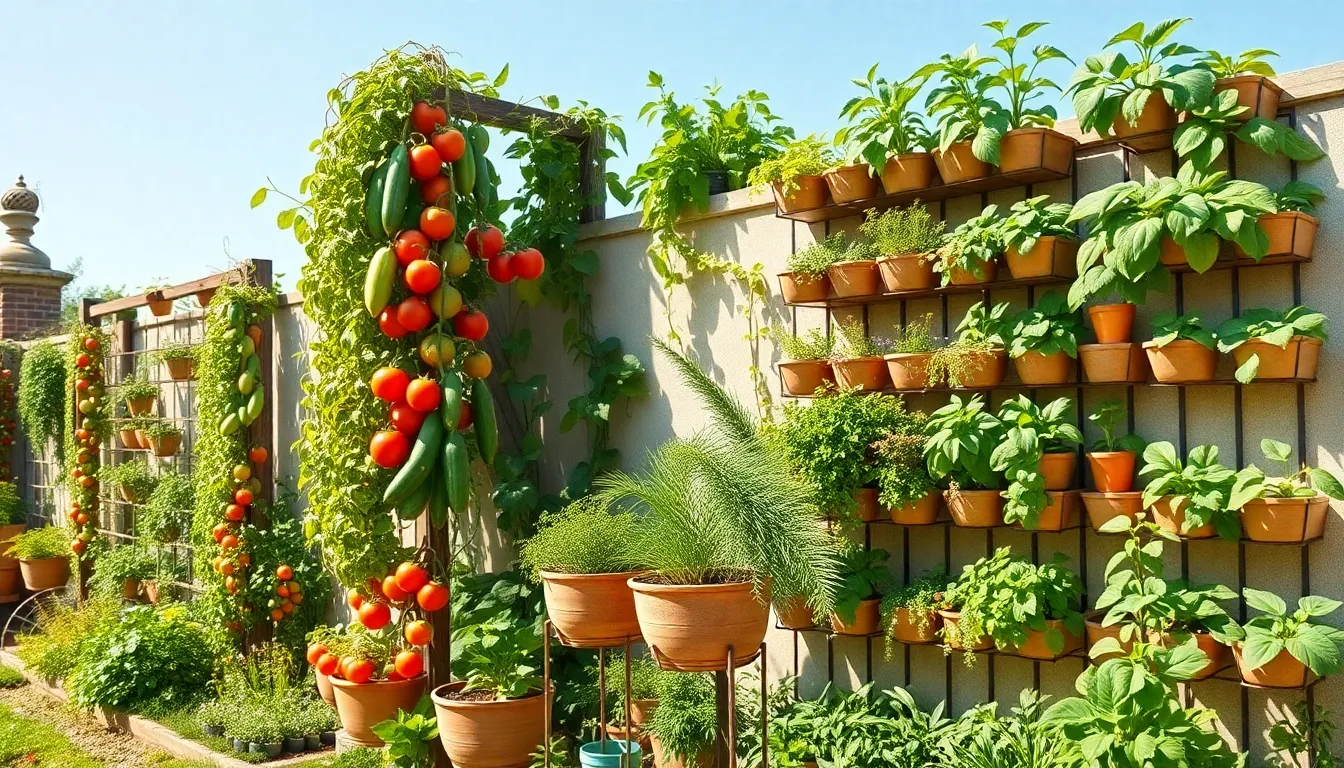
Maximizing garden space requires thinking beyond traditional horizontal layouts to embrace vertical growing answers. Growing upward transforms even the smallest areas into productive vegetable gardens.
Trellis Systems for Climbing Vegetables
Trellises create excellent support structures for vining vegetables while making efficient use of available space. Tomatoes, cucumbers, squash, peas, and pole beans thrive when given proper vertical support through well-designed trellis systems.
Double duty trellises mounted in the ground provide free-standing structures with two planting sides. Installing these systems allows us to grow twice as many climbing vegetables in the same footprint. Metal or wooden frames work equally well for creating sturdy support that handles the weight of mature plants.
Positioning trellises strategically ensures climbing vegetables receive adequate sunlight without shading shorter plants. We recommend placing taller trellis systems on the north side of garden beds to prevent blocking light from reaching other crops.
Wall-Mounted Growing Answers
Wall-mounted systems transform vertical surfaces into productive growing spaces without requiring ground area. Window boxes attached to walls or deck rails create versatile vertical gardens that accommodate various vegetables and herbs.
Living walls constructed from metal or wood structures support diverse plant collections while adding visual appeal. These systems work particularly well for growing salad greens, herbs, and compact vegetables that don’t require deep root systems.
Rain gutter gardens mounted on walls or fences create tiered growing environments perfect for shallow-rooted crops. Installing multiple levels of gutters maximizes the number of plants we can grow on a single vertical surface while maintaining easy access for harvesting.
Tiered Planting Structures
Tiered structures multiply growing space by creating multiple planting levels within a compact footprint. Stair step gardens built from repurposed ladders or custom shelving accommodate various plant sizes while providing excellent drainage and accessibility.
Salad towers constructed as cylindrical structures excel at growing lettuce, arugula, and spinach in minimal space. These vertical systems allow us to harvest fresh greens continuously while occupying only a few square feet of ground area.
Hanging gardens utilizing baskets or containers work perfectly for crops like strawberries and tumbling tomatoes. Suspending these systems overhead uses no ground space while keeping plants accessible for maintenance and harvesting.
Wood pallets repurposed as vertical planters offer budget-friendly answers for maximizing growing space. Mounting pallets vertically and adding flowerpot rings or shelves creates full garden displays that accommodate many plants in previously unused vertical areas.
Companion Planting Layout Strategies
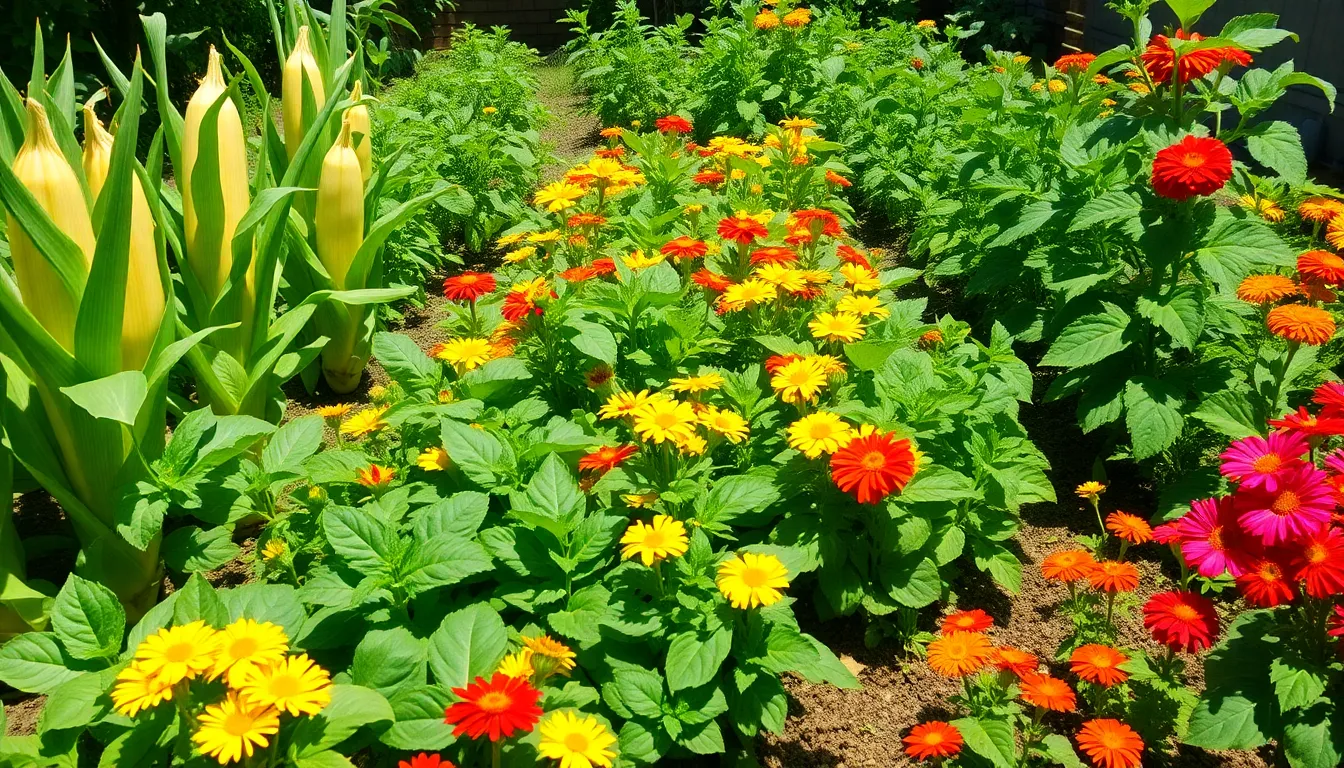
Maximizing your garden’s potential involves pairing vegetables that naturally support each other’s growth and health. We’ll explore proven companion planting techniques that help create thriving vegetable partnerships while reducing pest problems and improving yields.
Three Sisters Planting Method
Native American agricultural wisdom gave us this time-tested planting strategy that combines corn, beans, and squash in perfect harmony. Corn stalks serve as natural poles for bean plants to climb, eliminating the need for additional support structures. Beans contribute nitrogen to the soil through their root systems, providing essential nutrients for both corn and squash plants.
Squash plants spread their broad leaves across the ground, creating natural mulch that suppresses weeds and retains soil moisture. We recommend planting corn first, allowing it to reach 6 inches in height before adding beans around the base. Squash seeds go in last, positioned around the perimeter where their vines can spread without interfering with the other crops.
Pest-Deterrent Plant Combinations
Strategic plant partnerships create natural pest control systems that protect your vegetables without chemical interventions. Basil planted near tomatoes repels aphids and whiteflies while improving the flavor of your tomato harvest. Radishes scattered among cucumber plants deter harmful cucumber beetles that can damage your crop.
Nasturtiums serve as excellent companions for cabbage family plants, repelling aphids, whiteflies, and other common pests. We’ve found that marigolds planted throughout tomato beds effectively deter nematodes, microscopic worms that attack tomato roots and reduce plant vigor.
Beneficial Plant Partnerships
Certain vegetable combinations enhance each other’s growth and flavor through complementary root systems and nutrient exchange. Tomatoes thrive when paired with onions, celery, carrots, parsley, oregano, and basil, creating a natural network that improves both pest resistance and taste. Sunflowers provide valuable shade and wind protection for tomato plants while offering climbing support for smaller vegetables.
Carrots develop better flavor and growth when planted alongside sage, which releases compounds that enhance carrot development. Beans stabilize corn stalks with their climbing growth while contributing nitrogen that corn plants readily absorb, creating a mutually beneficial relationship that maximizes your garden space efficiency.
Succession Planting Layout for Continuous Harvests

Smart succession planting transforms our garden into a continuous production system that delivers fresh vegetables throughout the growing season. We can maximize harvests by strategically timing plantings and rotating crops to maintain soil health.
Staggered Planting Timeline Plans
Sequential sowing keeps our harvest flowing by planting the same crop every 1-2 weeks throughout the season. Lettuce and spinach respond particularly well to this approach, giving us fresh greens without overwhelming abundance all at once.
Interplanting techniques multiply our space efficiency by combining fast-growing crops like radishes with slower-developing vegetables such as tomatoes or peppers. We plant quick-maturing radishes between tomato transplants, harvesting them before the tomatoes need the full space.
The Three Sisters method creates a self-supporting network where corn provides natural trellises for climbing beans while squash spreads below to shade soil and retain moisture. This Native American technique reduces weeds naturally and maximizes our growing area’s productivity.
Family grouping systems organize vegetables into related categories like cabbage, nightshade, and pea families for easier rotation planning. We can track which crops have grown where and plan future seasons more effectively.
Rotating Crop Positions Throughout Seasons
Annual crop rotation prevents nutrient depletion and reduces disease by moving different vegetable families through our garden beds each year. Four-bed systems work perfectly for rotating cabbage, nightshade, pea, and root vegetable families annually.
Single bed rotations require creative positioning where we shift crop locations within the same bed yearly. Container growing becomes essential for the third year, particularly for heavy feeders like tomatoes that benefit from fresh soil.
Seasonal position changes keep soil balanced by alternating between heavy feeders, light feeders, and soil builders throughout different growing periods. We follow nitrogen-hungry crops with legumes that naturally replenish soil nutrients.
Disease prevention strategies break pest and pathogen cycles by ensuring the same plant families don’t occupy identical positions for consecutive seasons. This natural approach reduces our reliance on chemical interventions.
Fast-Growing Vegetable Rotation Systems
Row planting arrangements maximize sunlight exposure by running north to south with tallest plants positioned at the northern end. This configuration prevents shading issues that can reduce yields in shorter crops.
Block planting systems divide our garden into dedicated sections for exact vegetable groups that benefit from shared growing conditions. We can simplify both companion planting and rotation scheduling with this organized approach.
Quick turnover crops like arugula, baby spinach, and radishes can complete full cycles in 30-45 days, allowing multiple plantings in the same space. We use these fast growers to fill gaps between main season vegetables.
Succession timing charts help us plan optimal planting dates by working backward from desired harvest times. Spring crops get planted every two weeks until heat arrives, while fall plantings begin 10-12 weeks before first frost.
Container Vegetable Garden Layout Ideas
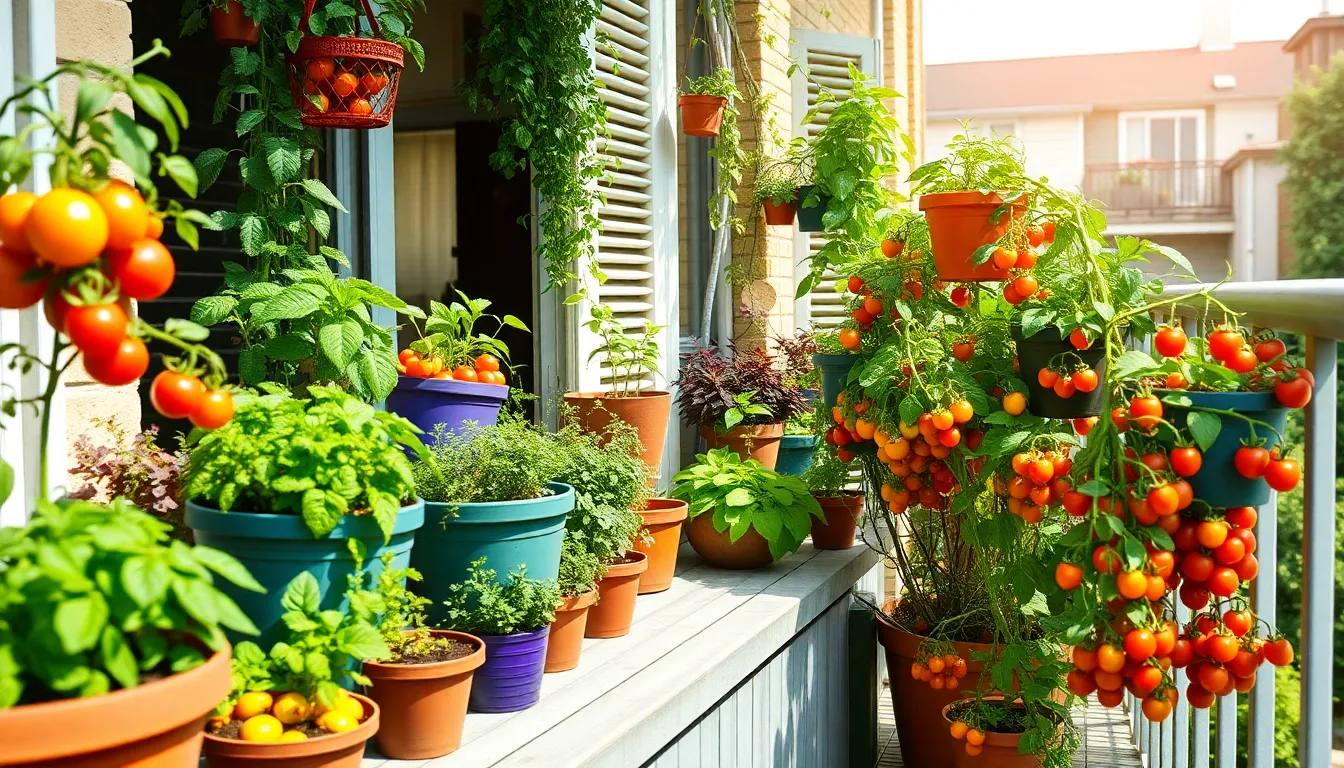
Container gardening transforms any space into a productive vegetable haven, whether you’re working with a small balcony or expansive patio.
Grouping Containers by Sun Requirements
Full sun vegetables thrive when we position their containers in locations receiving at least six hours of direct sunlight daily. Tomatoes, peppers, and achocha flourish in these bright spots, producing abundant harvests throughout the growing season. We recommend grouping these heat-loving plants together for easier maintenance and optimal growing conditions.
Partial shade arrangements work perfectly for vegetables requiring four to six hours of sunlight. Lettuce, herbs, and carrots adapt well to these moderate light conditions, allowing us to use areas that might otherwise remain unproductive. Positioning these containers in morning sun locations protects delicate leaves from harsh afternoon heat while maintaining healthy growth rates.
Creating Mobile Container Arrangements
Tiered planters create stunning vertical displays that maximize both space and visual appeal in container gardens. Stacking pots and crates allows us to grow multiple varieties in compact areas while maintaining easy access for harvesting and maintenance. These arrangements work exceptionally well for herbs and smaller vegetables that complement each other’s growing requirements.
Hanging baskets add dimension to container layouts while showcasing trailing vegetables like cherry tomatoes and peppers. We can suspend these baskets from pergolas, deck railings, or wall brackets to create productive overhead gardens. This approach saves valuable floor space while adding aesthetic value to any outdoor area.
Mobile pots equipped with casters provide ultimate flexibility for container gardening success. Rolling containers to follow optimal sunlight exposure throughout the day ensures plants receive maximum growing potential. We can easily rearrange mobile containers based on seasonal changes or evolving garden design preferences.
Maximizing Small Space Container Layouts
Vertical gardening utilizes walls and fences with specialized planters or trellises for climbing vegetables. Beans and peas naturally grow upward, making them perfect candidates for vertical container systems that multiply growing space without expanding the garden’s footprint. We can install these systems against any sturdy vertical surface for immediate space multiplication.
Compact containers include repurposed items like coffee cans for herbs and carrots, while larger containers accommodate space-hungry vegetables like tomatoes and peppers. Selecting appropriate container sizes ensures each plant receives adequate root space for healthy development. We match container size to mature plant requirements for optimal growing results.
Window sills and balconies become productive growing areas when we use hanging baskets or small pots strategically. These elevated locations often receive excellent light exposure while remaining easily accessible for daily care and harvesting. Maximizing these underutilized spaces transforms even the smallest urban areas into productive vegetable gardens.
Permaculture-Inspired Vegetable Garden Designs
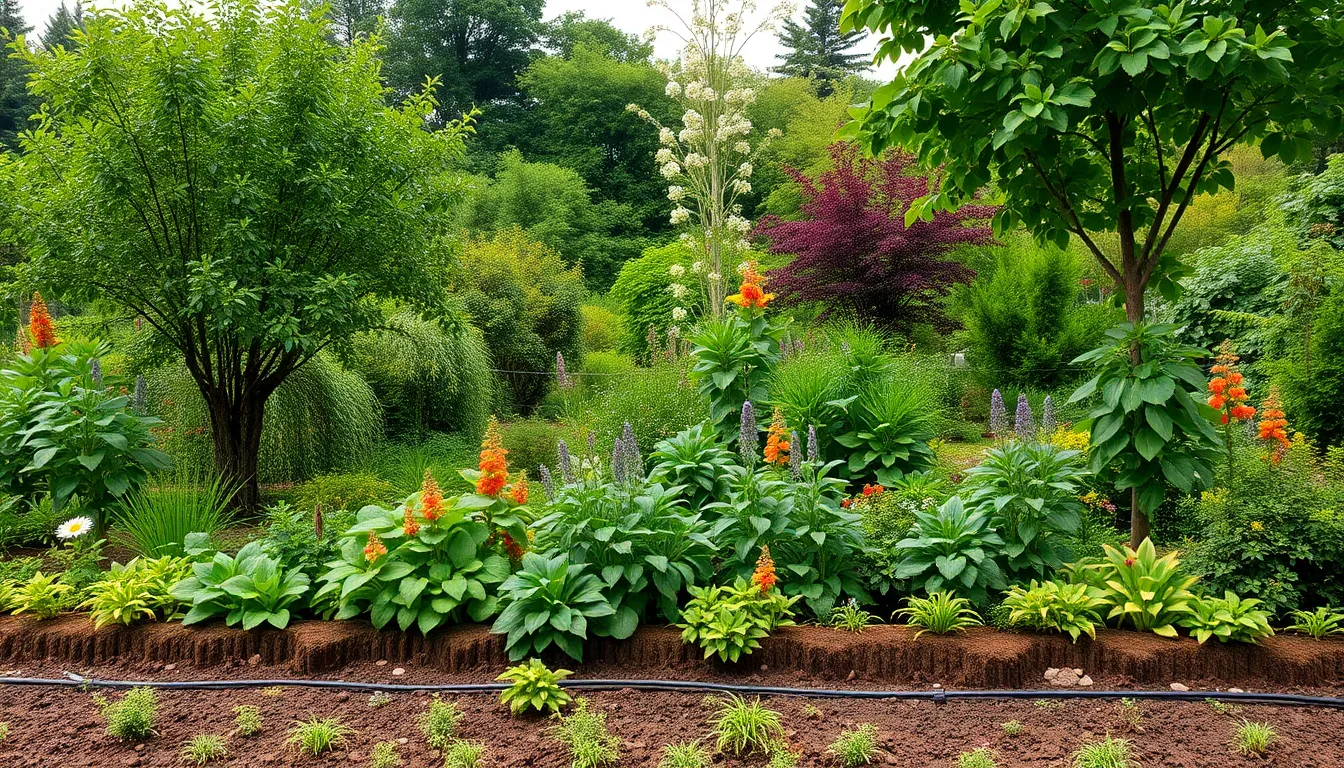
Permaculture transforms traditional vegetable gardening by creating sustainable, self-maintaining systems that work with natural processes. We’ll explore how these time-tested principles can revolutionize your garden layout and productivity.
Food Forest Layer Integration
Canopy trees form the foundation of our food forest design, providing essential structure and shade for the entire system. Oak, maple, or fruit trees create the uppermost layer while protecting smaller plants beneath them.
Understory plantings occupy the middle tier, where dwarf fruit trees and nut-bearing shrubs thrive in filtered sunlight. Elderberries, hazelnuts, and dwarf apple varieties produce abundant harvests in this productive zone.
Shrub layers house berry bushes and perennial herbs that require minimal maintenance once established. Blueberries, blackberries, and rosemary bushes create natural windbreaks while yielding consistent crops.
Herbaceous plants fill the main vegetable growing space, where annual crops like tomatoes, peppers, and leafy greens receive optimal light exposure. We position these seasonal vegetables in the brightest spots between permanent plantings.
Groundcover species carpet the soil with edible plants like wild strawberries, clover, and creeping thyme. These living mulches suppress weeds naturally while providing additional food sources.
Root vegetables use the underground rhizome layer, where potatoes, carrots, and Jerusalem artichokes store energy and nutrients. Deep-rooted plants in this layer help break up compacted soil and improve drainage.
Natural Network Mimicking Layouts
Polyculture plantings replicate nature’s diversity by combining multiple vegetable species in each growing area. We plant lettuce alongside radishes and carrots, creating beneficial relationships that enhance growth and pest resistance.
Companion partnerships pair vegetables that support each other’s development and health. Marigolds planted with tomatoes deter harmful insects while beans fix nitrogen in the soil for neighboring heavy feeders.
Biodiversity zones incorporate native plants and wildflowers throughout the vegetable garden to attract beneficial insects. Sunflowers, zinnias, and native grasses provide habitat for pollinators and natural pest predators.
Natural pest management relies on plant diversity rather than chemical interventions to maintain garden health. Aromatic herbs like basil and mint scattered throughout growing beds confuse and repel common garden pests.
Sustainable Water Flow Considerations
Rainwater collection systems capture and store natural precipitation for garden irrigation needs. We install rain barrels or larger cisterns to reduce dependence on municipal water sources.
Drip irrigation delivers water directly to plant roots with minimal waste or evaporation. These efficient systems reduce water consumption by up to 50% compared to traditional sprinkler methods.
Mulching strategies conserve soil moisture while suppressing weeds and enriching the growing medium. Organic materials like straw, leaves, and grass clippings create protective barriers that reduce watering frequency.
Swales and berms direct rainwater flow toward planted areas rather than allowing runoff to leave the property. These earthworks capture and infiltrate water naturally while preventing erosion.
Greywater systems redirect household wastewater from sinks and showers to irrigate vegetable gardens safely. Properly designed greywater systems reduce overall water consumption while nourishing plants with nutrient-rich water.
Seasonal Rotation Layout Planning
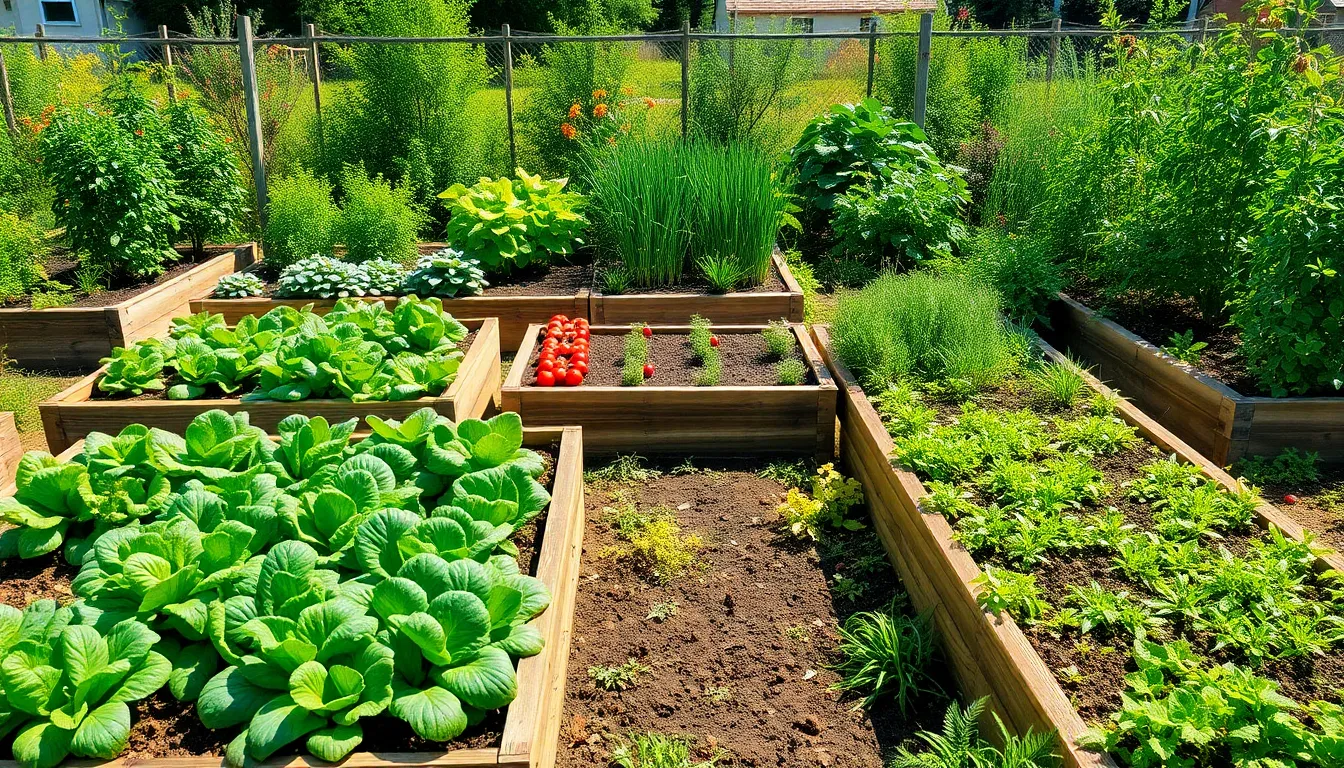
Maximizing our garden’s potential requires strategic planning that considers the natural rhythm of seasons. We can maintain continuous harvests while protecting soil health through thoughtful crop rotations throughout the year.
Four-Season Garden Bed Rotation
Multiple raised beds create the foundation for effective seasonal rotation systems. We divide our garden space into at least four separate sections, allowing different plant families to occupy distinct areas during each growing season.
Spring beds host cool-season crops like lettuce, spinach, and arugula that thrive in cooler temperatures. Summer sections transition to warm-season crops such as tomatoes, peppers, and eggplants once spring greens finish their harvest cycle.
Fall arrangements replace summer fruits with cool-season root vegetables like carrots, beets, turnips, and radishes. Winter plots accommodate cover crops like winter rye or hairy vetch that protect soil and add organic matter.
Rotating plant families prevents pests and diseases from building up in the soil over time. We move each crop group to a different bed section each season, ensuring no plant family returns to the same location for at least three years.
Cool Season vs. Warm Season Arrangements
Cool season crops require careful timing and placement for optimal growth conditions. We plant lettuce, spinach, broccoli, and carrots during early spring or late summer when temperatures remain moderate.
These vegetables prefer temperatures between 45-75°F and can tolerate light frosts. We position cool season beds in areas that receive morning sun but afternoon shade during summer months.
Warm season crops demand different environmental conditions and layout considerations. Tomatoes, peppers, and eggplants need consistent temperatures above 60°F and full sun exposure throughout the day.
We place warm season vegetables in our garden’s warmest, most protected areas after the last frost date. These crops benefit from south-facing positions and heat-reflecting surfaces like stone paths or light-colored mulch.
Winter Protection Layout Strategies
Cover crops maintain soil health during winter months while preventing erosion and nutrient loss. We plant winter rye or hairy vetch in empty beds after harvesting summer vegetables.
Cold-hardy vegetables extend our growing season in milder climates with proper protection strategies. Kale, Brussels sprouts, and garlic continue producing through winter when we provide adequate shelter.
Row covers and mulch layers shield vegetables from extreme weather conditions. We install floating row covers over cold-hardy crops and apply thick mulch around root zones to insulate plants.
Strategic positioning near south-facing walls or structures creates microclimates that extend growing seasons. We use these warmer zones for winter vegetables while reserving exposed areas for cover crops or garden rest periods.
Conclusion
Creating an effective vegetable garden layout doesn’t have to be overwhelming when you understand the core principles we’ve covered. Whether you choose traditional rows square foot gardening or innovative vertical systems each approach offers unique benefits that can transform your growing space.
The key lies in matching your chosen layout to your exact needs space constraints and gardening goals. We’ve shown you how companion planting succession techniques and seasonal rotation can maximize your harvest while keeping maintenance manageable.
Remember that the best garden layout is one you’ll actually use and maintain. Start with methods that feel comfortable then gradually incorporate more advanced techniques as your confidence grows. Your perfect vegetable garden is waiting – it’s time to make it happen.
Frequently Asked Questions
What is square foot gardening and how does it work?
Square foot gardening is a space-efficient method that divides garden beds into 4×4 foot raised sections, each containing sixteen individual square foot spaces. This approach maximizes vegetable yields in small areas while minimizing maintenance by organizing crops based on their specific needs and growth patterns, making it perfect for urban gardening.
How many plants should I put in each square foot?
Plant spacing depends on vegetable size: one plant per square foot for large vegetables like tomatoes, four plants for medium-sized crops like lettuce, nine plants for small vegetables like radishes, and sixteen plants for tiny crops like carrots or herbs. This ensures proper growth without overcrowding.
What vegetables work best in compact garden layouts?
The best vegetables for compact spaces include leafy greens (lettuce, spinach), compact root vegetables (radishes, carrots), bush varieties of sprawling plants, fast-growing herbs (basil, cilantro), and short-season crops that allow multiple plantings throughout the year for continuous harvests.
How should I arrange plants in a traditional row garden?
Organize plants in straight rows running north to south for optimal sunlight exposure. Place taller plants at the north end and shorter ones at the south to prevent shading. Use 30-inch wide rows for better moisture retention and maintain 2-3 feet wide pathways between rows for easy access.
What is companion planting and why is it important?
Companion planting pairs vegetables that benefit each other’s growth, pest resistance, and flavor. Examples include planting marigolds with tomatoes for pest control and beans with corn for nitrogen fixation. This natural partnership reduces the need for chemicals while improving overall garden productivity and health.
What are the advantages of raised bed gardening?
Raised beds offer superior drainage, better soil control, improved accessibility, and extended growing seasons. They warm up faster in spring, prevent soil compaction, and allow for precise soil amendments. Raised beds also make garden maintenance easier and can accommodate various layout designs for maximum efficiency.
How can I maximize space with vertical gardening?
Vertical gardening utilizes upward space through trellis systems for climbing vegetables, wall-mounted containers, and tiered planting structures. This method transforms walls, fences, and vertical surfaces into productive growing areas, making it ideal for small spaces like balconies, patios, or urban environments.
What is the Three Sisters planting method?
The Three Sisters is a Native American companion planting technique combining corn, beans, and squash. Corn provides support for beans to climb, beans fix nitrogen in soil to feed all three plants, and squash leaves shade the ground to retain moisture and suppress weeds.
How does succession planting work?
Succession planting involves staggering crop plantings every 2-3 weeks to ensure continuous harvests throughout the growing season. This technique prevents overwhelming harvests and extends production periods, allowing you to enjoy fresh vegetables consistently rather than having everything mature at once.
What is crop rotation and why is it necessary?
Crop rotation involves systematically changing which plant families grow in specific garden areas each season. This practice prevents soil depletion, reduces disease buildup, breaks pest cycles, and maintains soil health by alternating heavy feeders with nitrogen-fixing plants and soil-building cover crops.
Can I grow vegetables in containers successfully?
Yes, container gardening allows productive vegetable growing in limited spaces. Group containers based on sun requirements, use proper drainage, and choose appropriate container sizes for each vegetable type. Mobile arrangements and vertical techniques can maximize space utilization on balconies, patios, or small yards.
What is permaculture-inspired vegetable gardening?
Permaculture vegetable gardening creates sustainable, self-maintaining systems by integrating multiple plant layers, natural water flow management, and beneficial plant partnerships. This approach mimics natural ecosystems to enhance biodiversity, reduce maintenance, and create productive gardens that work with nature rather than against it.
How do I plan for year-round vegetable production?
Plan seasonal rotations by dividing garden space into sections for different plant families throughout the year. Plant cool-season crops in spring and fall, warm-season crops in summer, and use winter for cover crops or cold-hardy vegetables with protection strategies to extend the growing season.

